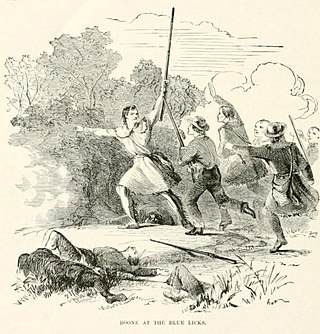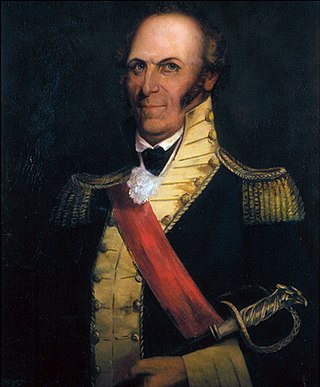Related Research Articles

Daniel Boone was an American pioneer and frontiersman whose exploits made him one of the first folk heroes of the United States. He became famous for his exploration and settlement of Kentucky, which was then beyond the western borders of the Thirteen Colonies. In 1775, Boone blazed the Wilderness Road through the Cumberland Gap and into Kentucky, in the face of resistance from American Indians, for whom the area was a traditional hunting ground. He founded Boonesborough, one of the first English-speaking settlements west of the Appalachian Mountains. By the end of the 18th century, more than 200,000 people had entered Kentucky by following the route marked by Boone.

Madison County is a county located in the central part of the U.S. state of Kentucky. At the 2020 census, its population was 92,701. Its county seat is Richmond. The county is named for Virginia statesman James Madison, who later became the fourth President of the United States.

Estill County is a county located in the U.S. state of Kentucky. As of the 2020 census, the population was 14,163. Its county seat is Irvine The county was formed in 1808 and named for Captain James Estill, a Kentucky militia officer who was killed in the Battle of Little Mountain during the American Revolutionary War. Estill County is a moist county meaning that the county seat, the city of Irvine, allows the sale of alcohol after the October 9, 2013 vote, but not the rest of Estill County outside the Irvine city limits. Estill County has two adjacent towns, known as the twin cities, Irvine and Ravenna. Both cities sit along the Kentucky River in the central part of the county. Ravenna is home to a former CSX Transportation facility, now owned by Kentucky Steam Heritage Corporation for the restoration of Chesapeake and Ohio 2716. It conducts the Ravenna Railroad Festival annually in late summer, and the historic Fitchburg & Cottage Furnaces are located here. Irvine hosts the annual Mountain Mushroom Festival over the last weekend of April, which celebrates the abundant Morel Mushrooms found in the region.

The Battle of Blue Licks, fought on August 19, 1782, was one of the last battles of the American Revolutionary War. The battle occurred ten months after Lord Cornwallis's surrender at Yorktown, which had effectively ended the war in the east. On a hill next to the Licking River in what is now Robertson County, Kentucky, a force of about 50 Loyalists along with 300 indigenous warriors ambushed and routed 182 Kentucky militiamen, who were partially led by Daniel Boone. It was the last victory for the Loyalists and natives during the frontier war. British, Loyalist and Native forces would engage in fighting with American forces once more the following month in Wheeling, West Virginia, during the Siege of Fort Henry.

Boonesborough or Boonesboro is an unincorporated community in Madison County, Kentucky, United States. Founded by famed frontiersman Daniel Boone in 1775 as one of the first English-speaking settlements west of the Appalachian Mountains, Boonesborough lies in the central part of the state along the Kentucky River and is the site of Fort Boonesborough State Park, which includes the Kentucky River Museum. The park site has been rebuilt to look like a working fort of the time that Boone resided there.

Benjamin Logan was an American pioneer, soldier, and politician from Virginia, then Shelby County, Kentucky. As colonel of the Kentucky County, Virginia militia during the American Revolutionary War, he was second-in-command of all the trans-Appalachian Virginia. He became a politician and help secure statehood for Kentucky. His brother, John Logan, who at times served under him in the militia and replaced him as delegate, became the first state treasurer of Kentucky.

The Wilderness Road was one of two principal routes used by colonial and early national era settlers to reach Kentucky from the East. Although this road goes through the Cumberland Gap into southern Kentucky and northern Tennessee, the other is sometimes called the "Cumberland Road" because it started in Fort Cumberland in Maryland. Despite Kentucky Senator Henry Clay's advocacy of this route, early in the 19th century, the northern route was selected for the National Road, connecting near Washington, Pennsylvania into the Ohio Valley of northern Kentucky and Ohio.

The western theater of the American Revolutionary War (1775–1783) was the area of conflict west of the Appalachian Mountains, the region which became the Northwest Territory of the United States as well as what would become the states of Kentucky, Tennessee, Missouri, and Spanish Louisiana. The western war was fought between American Indians with their British allies in Detroit, and American settlers south and east of the Ohio River, and also the Spanish as allies of the latter.

Charles Scott was an American military officer and politician who served as the governor of Kentucky from 1808 to 1812. Orphaned in his teens, Scott enlisted in the Virginia Regiment in October 1755 and served as a scout and escort during the French and Indian War. He quickly rose through the ranks to become a captain. After the war, he married and engaged in agricultural pursuits on land left to him by his father, but he returned to active military service in 1775 as the American Revolution began to grow in intensity. In August 1776, he was promoted to colonel and given command of the 5th Virginia Regiment. The 5th Virginia joined George Washington in New Jersey later that year, serving with him for the duration of the Philadelphia campaign. Scott commanded Washington's light infantry, and by late 1778 was also serving as his chief of intelligence. Furloughed at the end of the Philadelphia campaign, Scott returned to active service in March 1779 and was ordered to South Carolina to assist General Benjamin Lincoln in the southern theater. He arrived in Charleston, South Carolina, just as Henry Clinton had begun his siege of the city. Scott was taken as a prisoner of war when Charleston surrendered. Paroled in March 1781 and exchanged for Lord Rawdon in July 1782, Scott managed to complete a few recruiting assignments before the war ended.
William Whitley, was an American pioneer in what became Kentucky, in the colonial and early Federal period. Born in Virginia, he was the son of Scottish Presbyterian immigrants from northern Ireland, then the Ulster Plantation. He was important to the early settlement of the U.S. Commonwealth of Kentucky, where he moved with his family from Virginia. He served with the Kentucky militia during the Northwest Indian War.

The siege of Boonesborough was a military engagement which took place in September 1778 during the American Revolutionary War. On September 7, Shawnee chief Blackfish, who was allied to the British, led an attack on the Kentucky settlement of Boonesborough. Months before the battle, Blackfish had captured and adopted Daniel Boone, the founder of Boonesborough. Boone escaped the Shawnees in time to lead the defense of the settlement. Blackfish's siege was unsuccessful and was lifted after eleven days. Boone was then court-martialed by fellow officers who suspected him of harboring Loyalist sympathies. He was acquitted, but soon left the settlement.

A longhunter was an 18th-century explorer and hunter who made expeditions into the American frontier for as much as six months at a time. Historian Emory Hamilton says that "The Long Hunter was peculiar to Southwest Virginia only, and nowhere else on any frontier did such hunts ever originate."

James John Floyd (1750–1783) was an early settler of St. Matthews, Kentucky and helped lay out Louisville. In Kentucky he served as a Colonel of the Kentucky Militia in which he participated in raids with George Rogers Clark and later became one of the first judges of Kentucky.
Col. Johannes "John" Bowman was an 18th-century American pioneer, colonial militia officer and sheriff, the first appointed in Lincoln County, Kentucky. In 1781 he also presided as a justice of the peace over the first county court held in Kentucky. The first county-lieutenant and military governor of Kentucky County during the American Revolutionary War, Col. Bowman also, served in the American Revolution, many times, second in command to General George Rogers Clark, during the Illinois Campaign, which, at the time, doubled the size of the United States.

The Battle of Little Mountain, also known as Estill's Defeat, was fought on March 22, 1782, near Mount Sterling in what is now Montgomery County, Kentucky. One of the bloodiest engagements of the Kentucky frontier, the battle has long been the subject of controversy resulting from the actions of one of Captain James Estill's officers, William Miller, who ordered a retreat that left the rest of Estill's command to be overwhelmed by the attacking Wyandots.
John Logan was a military officer, farmer and politician from Virginia who became a pioneer in and helped found the state of Kentucky. He served under his brother, Benjamin during Lord Dunmore's War in 1774, then both moved to what was then called Kentucky County, Virginia. Logan took part in several expeditions against the Shawnee, including some led by Daniel Boone, John Bowman, and George Rogers Clark. After Kentucky County was split into three counties, Logan and his brother at various times represented Lincoln in the Virginia House of Delegates, and John Logan also represented that county at the Virginia Ratification Convention in 1788.
Samuel South was born circa 1770 in Maryland. He was the second son of John South. The South family moved to Boonesborough when Samuel was still young. At the time, Boonesborough was in Fayette County in the District of Kentucky, a part of the state of Virginia. John South was in command of the militia at Boonesborough.
Hugh McGary was an Irish-born American military officer and landowner who was the founder of McGary Station in present-day Oregon, Kentucky.

Captain James Ward was an early American settler, Indian fighter and legislator of Kentucky whose adventures featured heavily in the stories of the western frontier. He was a pall bearer at Daniel Boone's re-interment in 1845.

David Glenn was of Irish descent and was born in 1753, likely in Pennsylvania but possibly in Virginia. He was one of the early settlers of Kentucky having accompanied James Harrod in founding Harrodstown in 1774, along with his older brother, Thomas. Today, Harrodsburg is considered the oldest permanent white settlement in Kentucky, being it was settled almost a full year before Boonesborough.
References
- ↑ Fort Boonesborough Foundation.
- ↑ Smith, Zachariah. 1885. The History of Kentucky. Louisville, KY: Courier-Journal Job Printing Company, p. 189.
- ↑ Deposition of Peter Hackett, taken Wednesday the 8th of May 1811. Madison County, Kentucky Circuit Court